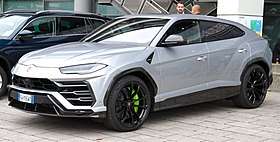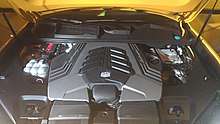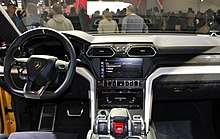Lamborghini Urus
The Lamborghini Urus is an SUV manufactured by Italian automobile manufacturer Lamborghini. It was unveiled on 4 December 2017 and was put on the market for the 2018 model year.[3] The name comes from the Urus, the ancestor of modern domestic cattle, also known as the aurochs.[4]
| Lamborghini Urus | |
|---|---|
 | |
| Overview | |
| Manufacturer | Lamborghini |
| Production | February 2018–present |
| Model years | 2018–present |
| Assembly | Italy: Sant'Agata Bolognese |
| Designer |
|
| Body and chassis | |
| Class | Mid-size luxury crossover SUV |
| Body style | 5-door SUV |
| Layout | Front-engine, four-wheel-drive |
| Platform | VW MLBevo |
| Related | |
| Powertrain | |
| Engine | 4.0 L FSI twin-turbocharged V8 |
| Power output | 478 kW (641 hp; 650 PS) |
| Transmission | 8-speed ZF 8HP automatic[2] |
| Dimensions | |
| Wheelbase | 3,002 mm (118.2 in) |
| Length | 5,113 mm (201.3 in) |
| Width | 2,017 mm (79.4 in) |
| Height | 1,638 mm (64.5 in) |
| Curb weight | 2,200 kg (4,850 lb) |
| Chronology | |
| Predecessor | Lamborghini LM002 |
Concept

The Lamborghini Urus concept was unveiled at the 2012 Beijing Auto Show on 23 April 2012.[5] Later, the SUV was also shown at Pebble Beach in 2012. Powered by a 5.2 L V10 engine shared with the Gallardo, the engine generated a theoretical maximum power output of 600 PS (592 hp; 441 kW) and was accompanied with an all-wheel drive system. The Urus was reported to have the lowest carbon emissions as compared to its stablemates (i.e. the Porsche Cayenne, Bentley Bentayga and the Audi Q7). The Urus was conceived as a perfect daily driver unlike the other offerings from the brand. The sharp-lined exterior design of the SUV takes heavy influence from the company's V12 flagship, the Aventador. The production version of the SUV was introduced in 2017 with major changes done to the exterior and featuring a different powertrain than that of the concept.[6]
Powertrain

The Lamborghini Urus does not use Lamborghini's hallmark of naturally aspirated V10 (as used in the concept) or V12 engines. Instead, the Urus is powered by a 650 PS (641 hp; 478 kW) 4.0 L twin-turbocharged V8, a modified version of Audi's 4.0 L V8.[7][8] This engine has application in other VW Group cars, including both the Porsche Cayenne and Panamera, as well as some of the Audi S and RS models, the A8, the Bentley Continental V8 and the Flying Spur V8. The engine has been heavily reworked though, and is uprated by 100 PS (74 kW; 99 hp) and 80 N⋅m (59 lbf⋅ft) of torque more than the Cayenne Turbo, with changes such as new cylinder heads. The engine is assembled at a Volkswagen plant in Hungary and is shipped to Lamborghini's assembly plant.
Specifications and performance


The Lamborghini Urus is much lighter than most of its competitors (i.e. the BMW X6 M, Bentley Bentayga and Rolls-Royce Cullinan, but not the Porsche Cayenne) at less than 2,200 kg (4,850 lb) as quoted by the manufacturer[9] mainly because of the extensive usage of carbon fibre reinforced polymer, although it is based on the same platform as the Audi Q7, Bentley Bentayga, Porsche Cayenne, and Volkswagen Touareg.[10]
The engine is rated at a maximum power output of 478 kW (641 hp; 650 PS) at 6,000 rpm and maximum torque of 850 N⋅m (627 lb⋅ft) at 2,250–4,500 rpm. The Urus has a front-engine, all-wheel-drive layout,[10][11] and a top speed of 305 km/h (190 mph) making it one of the world's fastest production SUVs. The Urus can accelerate from 0–100 km/h (62 mph) in 3.6 seconds and 0–200 km/h (124 mph) in 12.8 seconds.
Lamborghini has developed the world's largest set of carbon ceramic disc brakes for the Urus, with 440 mm (17.32 in) discs in the front and 370 mm (14.57 in) discs in the rear using ten-piston callipers at the front and single-piston callipers at the rear. The all-wheel drive system of the Urus under normal driving sends 40 percent of the engine's torque to the front wheels and 60 percent to the rear wheels. It also uses torque vectoring to send as much as 70 percent to the front or 87 percent to the rear when necessary. The SUV also features rear-wheel steering and an air suspension system that can provide a maximum of 250 mm (9.8 in) of ground clearance for off-road use. The SUV is available with an optional off-road package, which includes modified front and rear bumpers that are better suited to the task.
The Urus, like all of Lamborghini's current offerings, features a selection of driving modes, which adapt the suspension to improve the car's performance in various driving conditions. The Lamborghini Urus features Strada (street), Sport, Corsa (track), Terra (dirt), Sabbia (sand), and Neve (snow) driving modes, with the latter three possibly only available on the off-road package offered. The Urus has a seating capacity of four to five people.[12]
Production
On 4 December 2017, the Urus was unveiled at Lamborghini's Sant'Agata Bolognese headquarters, making it the brand's first SUV since the LM002.[13][14] Production began in February 2018 and Lamborghini plans to build 1,000 units in the first year of production, and 3,500 in 2019.[15] Lamborghini has expanded their factory in Sant'Agata Bolognese, Italy, to produce the Urus.
Earlier appearance of the name
Lamborghini had trademarked the name "Urus" before the introduction of the Lamborghini Estoque at the 2008 Paris Motor Show, and automotive news blogs Jalopnik and Autoblog believed that the name would be applied to what was eventually found to be the Estoque.[16][17]
See also
- Lamborghini LM002, the V12-powered spiritual predecessor to the Urus (1986-1993)
References
| Wikimedia Commons has media related to Lamborghini Urus. |
- Matthew Debord (16 January 2018). "Designer of the Lamborghini Urus". Retrieved 5 February 2018.
- John Pearley Huffman (April 2018). "2019 Lamborghini Urus". Car and Driver. Retrieved 25 May 2018.
- 2019 Lamborghini Urus: Everything We Know www.motor1.com
- "Lamborghini Urus". Pebble Beach Concours d'Elegance program: 134. August 2012.
- "Drive News - Lamborghini Urus SUV". 22 April 2012.
- Jay Traugott (22 April 2012). "Lamborghini Urus concept revealed". Carbuzz. Retrieved 5 February 2018.
- "Lamborghini Urus Reviews | Lamborghini Urus Price, Photos, and Specs | Car and Driver". Car and Driver. Retrieved 3 August 2018.
- "New Lamborghini Urus SUV revealed in full – due in 2018". Evo. Retrieved 3 August 2018.
- "Lamborghini Urus Dimensions". Retrieved 5 February 2018.
- Kable, Greg (30 April 2012). "Lightning Lamborghini". Autoweek. 62 (9): 10. Archived from the original on 25 April 2012. Retrieved 4 May 2012.
- "Lamborghini Urus SUV". 23 April 2012. Archived from the original on 20 October 2017. Retrieved 23 April 2012.
- "The Lamborghini Urus is the latest $200,000 SUV". The Verge. Retrieved 5 December 2017.
- "Report: Lamborghini Boss Confirms Urus SUV Will Go Into Production". Top Gear Philippines. 26 September 2013. Retrieved 26 September 2013.
- Vijayenthiran, Viknesh (14 May 2013). "Lamborghini Urus SUV Approved for Production in 2017". Motor Authority. Retrieved 27 September 2013.
- "2019 Lamborghini Urus SUV Horsepower Revealed by CEO". Retrieved 7 November 2017.
- Wojdyla, Ben (22 September 2008). "Lamborghini Urus Four-Door Concept Coming To Paris, Fittingly Named After A Big German Cow". jalopnik.com. Retrieved 5 May 2012.
The lid on the mysterious Lamborghini teaser images has cracked open a bit wider today, and what we see inside is the Lamborghini Urukakflfls, a four-door, front-engined, super saloon to compete against the Porsche Panamera and the Aston Martin Rapide.
- Wojdyla, Ben (26 September 2008). "Lamborghini Estoque Is The Lamborghini Urus?". jalopnik.com. Retrieved 5 May 2012.
Seems the trademark claim Lamborghini placed on the name "Urus" may have been a red herring and the real name of the four-door super saloon set to debut at the Paris Motor Show may be the Lamborghini Estoque.